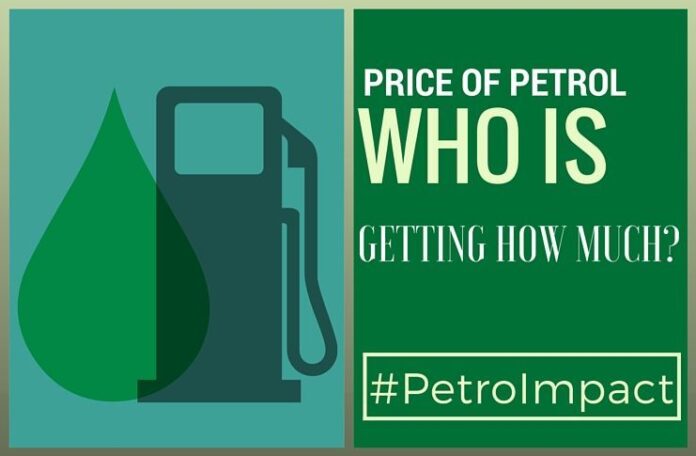
New Delhi
[dropcap color=”#008040″ boxed=”yes” boxed_radius=”8px” class=”” id=””]O[/dropcap]ur observations about India not passing the benefits of a lower crude price seems to have touched a nerve. Among the developed countries, except for the United States, others have also not passed on the benefits of a lower crude to the consumer. While Western Europe is well connected by rail, a cut in price of petrol (or gas) may not make much of a difference to the residents there; however it does have a huge impact in an emerging nation like India. Let us examine the reasons for the correction in price of Crude…
The chart below shows the prices of Crude, Petrol and Diesel in rupees for the years 2013 through 2016. Crude price falls below the Retail prices in 2015 which indicates that the Government was subsidizing Petrol and Diesel retail prices till 2014. For more, see the chart below:
Record production in the US, weakened demand from the Eurozone and emerging economies like China and Brazil, and Iran’s entry into the international market have effectively slashed the price of crude oil for India, from $106 per barrel in July 2014 to $26 in January 2016 – a 75 percent drop over 15 months. So, why is the consumer not seeing evidence of this price-cut at your local petrol and diesel station?
The answer: As global crude prices reach a 11-year low, the Center and State governments steadily increase excise duties and value-added tax, shoring up their revenues and keeping fuel prices high for retail consumers.
[dropcap color=”#008040″ boxed=”yes” boxed_radius=”8px” class=”” id=””]A[/dropcap]lthough India imports more than 80 percent of its fuel requirements, which means declining global prices should, theoretically, have seen sharp declines in retail petrol and diesel prices, Indian consumers of petrol and diesel now pay about double the global rate.
A series of taxes, oil-company profits and other commissions – Below is a list of items that are contributing to the price of petrol:
-
Indian prices stay high because oil marketing companies (OMCs), such as Indian Oil Corporation Ltd, Hindustan Petroleum Corporation Ltd and Reliance Industries Ltd., add their margins, the central government adds excise, state governments add their own (value-added) taxes, and the dealers (petrol pumps) get their commission. The total of these is the retail price of the fuel you pay.
-
Excise hiked five times in three months; diesel duty hiked 140 percent. The excise duty on petrol and diesel has been hiked five times over the last three months, increasing the excise duty on petrol by 34%. On diesel, excise duty has increased by 140 percent.
-
The price at which OMCs sell petrol to dealers (petrol pumps) has been halved in two years. Over the same period, retail petrol prices have come down only by 15 percent.
-
The value-added taxes imposed by states have more or less remained the same, but excise duties – both basic and additional – imposed by the centre have doubled between 2014 and 2016. You pay more taxes on diesel and petrol than the price of fuels!
-
The addition of central taxes on diesel is higher than those on petrol. Central taxes per litre of diesel rose to four times its value in April 2014 – from Rs 4.52 per litre to Rs 17.33 per litre in February 2016.
-
Retail consumers pay more tax on petrol and diesel than its actual price. Of the price you pay for a litre of petrol, 57 percent goes to the government as tax. Of the Rs 44 per litre of diesel, 55 percent is tax.
If the excise duties on diesel had not been increased these two years, diesel would have cost Rs.32 per litre today, other factors remaining the same.
[dropcap color=”#008040″ boxed=”yes” boxed_radius=”8px” class=”” id=””]T[/dropcap]he direct effect of oil prices on cost of transportation of goods and thus consumer inflation has been demonstrated by research from Integrated Research and Action for Development (an autonomous research institute), as journalist and economist Swaminathan Anklesaria Aiyar wrote in his blog.
Research on inflation in Turkey and Sri Lanka has underlined the effect of fuel prices on inflation.
Lower fuel prices can keep inflation in check, according to a report in Business Standard.
Note:
1. Text in Blue points to additional data on the topic.
2. Portions of the content from IANS.
- Indian Parliament’s Special Session is convened to mark the shifting to new Parliament building - September 3, 2023
- Why did Rajat Sharma of India TV not declare that Adani owns more than 16% shares in his channel? - January 29, 2023
- Prannoy Roy to get Rs.605 crore from Adani as per Stock Exchange filing. Why is Income Tax not acting on Roys’ dues of over Rs.800 crore? - January 4, 2023










